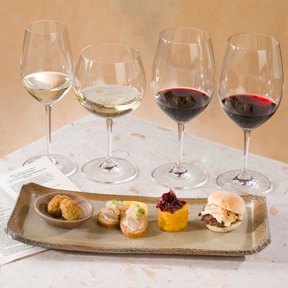Wine & Food MatchingLearn the Art and Science of Wine & Food Matching |
||
In This Issue |
Off the Vine
Wine & Food MatchingScience or Art?W
ine is always called a combination of art and science, and in our schools cooking is always called a food science. If anything, the “art” of matching wine and food has always been one of the least understood aspects of wine appreciation, and a lot of that is because many of our leading wine “experts” (journalists, winemakers, judges, etc.) simply do not understand the science behind the concept. 
This is understandable because much of what we know about wine and food matching is a priori – a matter what we know from tried-and-true experience. Therefore, experts and everyday people alike know a good Cabernet Sauvignon is a good match for roast beef, but can we really explicate the sensory reasons why? One could make a valid point that explication has never really been necessary, but consider the cooking done by many of our restaurant chefs, and by ourselves at home, today: beef is no longer just roasted. Nowadays we’ll marinate it in salty-sweet-spicy marinades, drench it in sweet fruit or Port infused demi-glace, serve it with hot-vinegary barbecue sauces, douse it lime and chili peppers, top it with lemony couscous or tropical fruit salsas, and on and on. Are these, then, the ideal matches for a typically big, hefty Cabernet Sauvignon? You can say yes; but objectively speaking, there are probably a number of other red wines that could make a better match. So if anything, an understanding of wine and food matching from a sensory or scientific perspective is exactly what we need this complicated culinary age. But I’ve always found it helpful to start with a simple premise: that foods and wines are matched in the exact same way as the way they are tasted – on the palate, where it comes together. In other words, wines are matched with dishes the same way that, say, a scoop of vanilla ice cream is matched with a dollop of hot chocolate syrup, sliced bananas, whipped cream, nuts and a cherry – a plethora of delicious, complimenting sensations. Vanilla ice cream, on the other hand, is not a good match with ketchup and anchovies. We may know this, but do we know why? In the course of my own work in the culinary industry over the years I’ve found it helpful to know and understand the following six basic principles that help us understand wine and food matching in more of an empirical rather than vague or instinctive way: 1st Principle: WINE IS A FOODAll food and wine matching is more easily understood when the taste components of wines are thought of in the same way as ingredients in a dish. Just like good cooking involves a balancing of ingredients and technique, good wine/food matching involves focusing on how specific components in wines interact and achieve a sense of balance and harmony with specific components in dishes. |
|
Feature Stories Also in this Issue |
||

|
||
|
Food and Beverage Today is the #1 Choice of Industry Insiders Online
Subscribe |
Advertise |
Write for Us |
Contact Us |
Privacy Policy |
Content-type: text/html
Copyright © 2019 FoodandBeverageToday.com. All Rights Reserved. | ||







